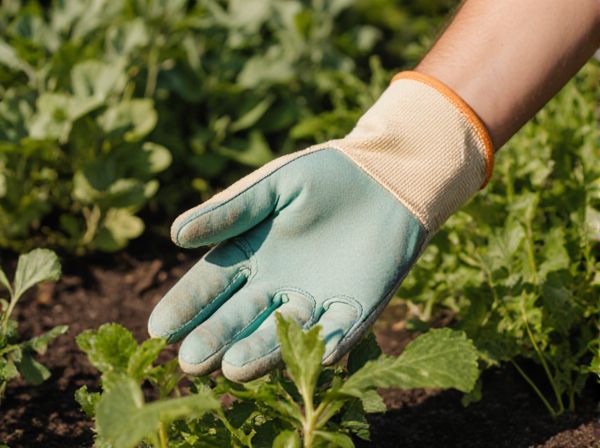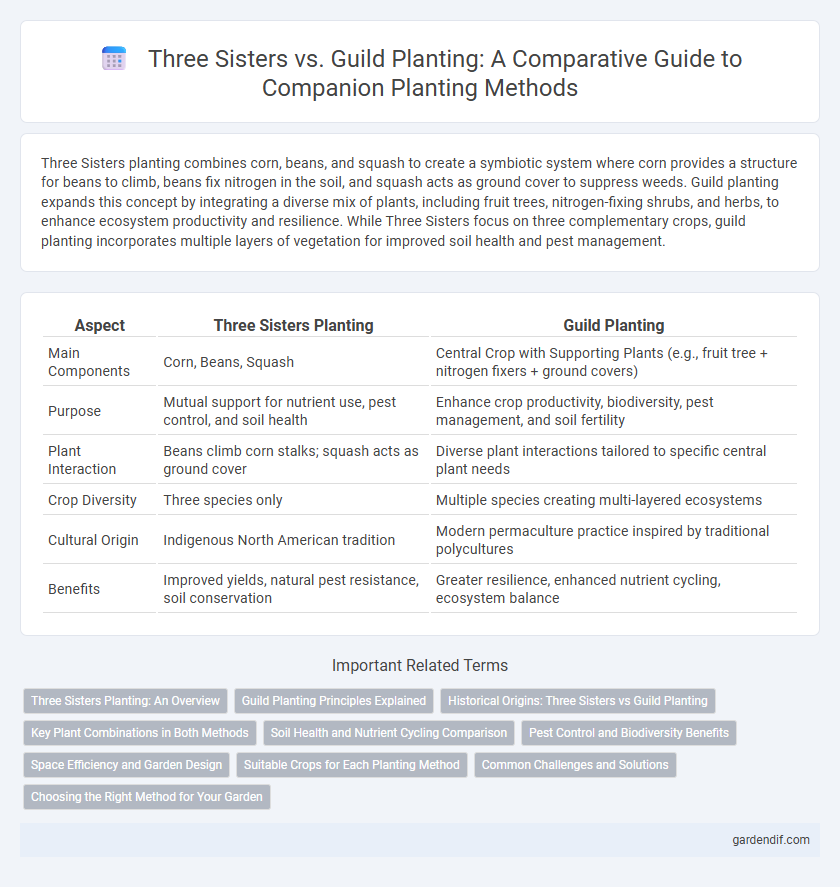
Three Sisters vs Guild planting Illustration
Three Sisters planting combines corn, beans, and squash to create a symbiotic system where corn provides a structure for beans to climb, beans fix nitrogen in the soil, and squash acts as ground cover to suppress weeds. Guild planting expands this concept by integrating a diverse mix of plants, including fruit trees, nitrogen-fixing shrubs, and herbs, to enhance ecosystem productivity and resilience. While Three Sisters focus on three complementary crops, guild planting incorporates multiple layers of vegetation for improved soil health and pest management.
Table of Comparison
| Aspect | Three Sisters Planting | Guild Planting |
|---|---|---|
| Main Components | Corn, Beans, Squash | Central Crop with Supporting Plants (e.g., fruit tree + nitrogen fixers + ground covers) |
| Purpose | Mutual support for nutrient use, pest control, and soil health | Enhance crop productivity, biodiversity, pest management, and soil fertility |
| Plant Interaction | Beans climb corn stalks; squash acts as ground cover | Diverse plant interactions tailored to specific central plant needs |
| Crop Diversity | Three species only | Multiple species creating multi-layered ecosystems |
| Cultural Origin | Indigenous North American tradition | Modern permaculture practice inspired by traditional polycultures |
| Benefits | Improved yields, natural pest resistance, soil conservation | Greater resilience, enhanced nutrient cycling, ecosystem balance |
Three Sisters Planting: An Overview
Three Sisters planting is a traditional companion gardening technique that involves growing corn, beans, and squash together to maximize space and yield. Corn serves as a natural trellis for climbing beans, while beans fix nitrogen in the soil, enhancing fertility, and squash spreads on the ground to suppress weeds and retain moisture. This symbiotic system boosts soil health and supports sustainable agricultural practices, making it a time-tested method for diverse, high-yield gardens.
Guild Planting Principles Explained
Guild planting focuses on creating synergistic plant communities where species support each other's growth through nutrient cycling, pest control, and microclimate creation. Unlike the Three Sisters method, which centers on maize, beans, and squash interactions, guild planting integrates a broader variety of plants, including nitrogen-fixing legumes, dynamic accumulators, and attractors for beneficial insects. This approach maximizes biodiversity and sustainability by mimicking natural ecosystems, improving soil health, and enhancing overall garden productivity.
Historical Origins: Three Sisters vs Guild Planting
Three Sisters planting, rooted in Native American agricultural traditions, combines corn, beans, and squash in a symbiotic trio promoting soil fertility and mutual support. Guild planting, derived from permaculture principles, integrates diverse plant species with complementary functions, such as nitrogen fixers and pest repellents, to create resilient companion systems. Both methods reflect ecological knowledge but differ historically, with Three Sisters emerging from indigenous practices and guild planting evolving as a modern sustainable farming technique.
Key Plant Combinations in Both Methods
Three Sisters planting combines corn, beans, and squash in a mutually beneficial arrangement where corn provides a natural trellis for beans, beans fix nitrogen to enrich the soil, and squash spreads to suppress weeds and retain moisture. In contrast, Guild planting extends this concept by incorporating diverse plants such as nitrogen-fixing legumes, dynamic accumulators, ground covers, and pest-repellent herbs around a central fruit or nut tree to create a resilient ecosystem. Both methods emphasize strategic plant combinations that enhance growth, soil fertility, and pest control, with Three Sisters focusing on staple crops and Guild planting integrating broader biodiversity for sustainable agriculture.
Soil Health and Nutrient Cycling Comparison
Three Sisters planting combines corn, beans, and squash, enhancing soil health by promoting nitrogen fixation through beans and providing ground cover that reduces erosion. Guild planting incorporates a diverse mix of complementary species, boosting nutrient cycling by fostering beneficial microbial activity and organic matter decomposition. Both methods improve soil fertility, but guild planting often offers a more dynamic nutrient exchange due to greater plant diversity and layered root systems.
Pest Control and Biodiversity Benefits
Three Sisters planting combines corn, beans, and squash to create a synergistic ecosystem that naturally deters pests through plant diversity and mutual support. Guild planting involves grouping compatible plants to enhance pest control by attracting beneficial insects and creating habitat diversity, promoting a balanced ecosystem. Both methods improve biodiversity, but Three Sisters planting uniquely leverages traditional companion planting principles to optimize pest resistance and soil health simultaneously.
Space Efficiency and Garden Design
Three Sisters planting--corn, beans, and squash grown together--maximizes vertical and horizontal space by combining climbing beans with tall corn stalks and sprawling squash. Guild planting incorporates diverse species with functional roles, optimizing space through layered planting and beneficial plant interactions in smaller areas. Three Sisters excels in traditional, high-density arrangements, while guild planting offers more flexible, aesthetically pleasing garden designs with efficient resource use.
Suitable Crops for Each Planting Method
Three Sisters planting combines corn, beans, and squash, where corn supports bean vines, beans fix nitrogen, and squash covers soil to retain moisture, ideal for nutrient cycling and space efficiency. Guild planting incorporates diverse species like nitrogen fixers, dynamic accumulators, and ground covers tailored to specific ecosystems, promoting biodiversity and resilience. Suitable crops for Three Sisters emphasize corn, climbing beans, and sprawling squash, while guilds can include fruit trees, herbs, and nitrogen-fixing shrubs adapted to the local environment.
Common Challenges and Solutions
Three Sisters and Guild planting both face common challenges such as pest management, nutrient competition, and water requirements. Effective solutions include selecting compatible plant varieties, implementing crop rotation, and using organic mulches to retain moisture and suppress weeds. Proper spacing and companion planting techniques enhance mutual benefits and reduce resource conflicts.
Choosing the Right Method for Your Garden
When selecting between Three Sisters and Guild planting methods, consider your garden's space, crop diversity, and maintenance level. Three Sisters, combining corn, beans, and squash, creates a symbiotic system ideal for limited space and improved soil fertility through nitrogen fixation. Guild planting incorporates a variety of complementary plants, enhancing pest control and resilience, perfect for larger or more diverse gardens seeking ecological balance.
Three Sisters vs Guild planting Infographic

 gardendif.com
gardendif.com